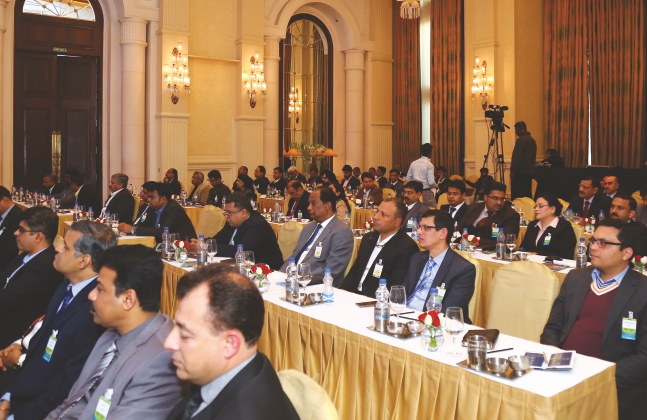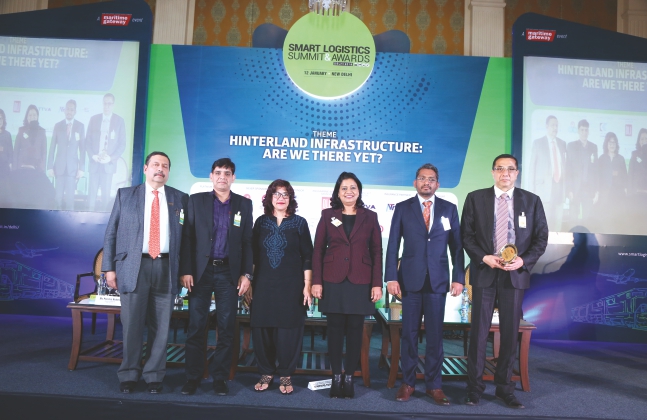Inland haulage charges need to be made more equitable and hub and spoke model can bring down rail haulage cost, averred the panellists. They also called for improvement in Customs procedures for cargo clearance, need for more focus on soft infrastructure such as regulatory or statutory regime and developing warehousing and better logistics network for moving agri-produce
The second session of the day focused on the growth of exim trade in north and central India. Tarun Kalra, Vice President- North India, MSC Agency (India) Pvt Ltd, observed that the present day maritime trend of port-led development was gradually shifting the export industry to the coastal areas. The export volumes had not developed as much as imports. He however conceded that the shift to the port areas was perhaps necessary for India to remain globally competitive. However due to its demographic concentration imports, had maintained a sustained growth in the hinterland areas.
Kalra asserted that there was a requirement for the Inland Haulage charge to be more equitable to sustain cargo movement to and from the north. A brief calculation of the haulage figures revealed that the comparison of the cost of moving container by rail vis a vis road was slanted in favour of road transport.
He however was of the opinion that very little could be done with regard to reducing the rails haulage charges, but there were other factors that could contribute to reducing the charges. One such measure was to have a hub and spoke arrangement which could significantly contribute towards reduction of haulage costs. This should be available for all the train operators.
Poroma Munshi Rebello, Director- Commercial, APL IndiaLinx, the moderator, concurred with Kalra’s statements. She went on to further elucidate stating that about 10 to 12 years ago the CAGR of the ICD business, north and central, was about 18 percent and north India was “jewel in the exim crown” for India. This was the reason why no shipping line could survive a mainline call into JNPT without the critical mass from north India. It was imperative to retain the ICD business and prevent it from moving away to the ports. Retaining business at the ICDs would mean more visibility and control for the exporters/ importers on their cargo and would not need to depend on a third party at the far away port.
Further Rebello said that with roadways gaining traction, the carbon footprints would only result in increase. There was one third less in carbon dioxide emission if the cargo was to move by rail.
She further stated that the ports on the east coast had been trying to woo cargo from the north. However owing to high haulage charges the movement was not productive.
Vikyath Kumar, Sales Director, Hapag-Lloyd India Pvt Ltd, also emphasised that it was important for railways to take precedence in transportation of cargo to the ports to avoid congestion on the roads. He cited the example of Bangladesh which had only one ICD. Thus a bulk of the cargo perforce had to move to the port by road causing delays in shipments. He however felt that the shift of cargo movement to the road was only temporary. The movement of cargo by rail would eventually reverse and take precedence.
Atul Kumar Saxena, President, Indian Importers Chambers of Commerce & Industry said his chamber was the only organisation that looked after the interests of the importers on various issues such as measures to reduce the cost of imports inter alia. Most of the cargo coming into Ludhiana is for value addition. These products are then re-exported. If the import cargoes are cheaper it also makes the export product competitive in the international market. He sees steady increase in imports to the northern region which he felt was likely to continue.
He also felt that there should be a healthy competition with CONCOR to improve rail services. He also stated that there should be more ICDs in remote regions. Further he felt that the Customs should improve the clearance procedures since many importers continued to face problems with clearance of their cargo. Imports are important. Imports leads to investment which in turn lead to industries. Hyundai, Hitachi etc are such examples. Importers pay to the Government which forms a big source of revenue for them, he clarified.

Vinita Venkatesh, Director, Krishnapatanam Port Container Terminal & MD, Ocean2Door, talked of the port which was constructed and promoted by the CVR Group. It was a greenfield port owing to which there are no industries around it. It was therefore important for them to have very good road and rail connectivity. They were trying to promote the Krishnapatanam port as a mega transshipment port on the east coast of India so that the vessels can tranship there instead of Singapore or Colombo or Malaysia.
Currently the port has rail connectivity with Hyderabad and Bangalore. When the Banglore connection was made, there was a fear that trains carrying cargo to Chennai would be affected by diversion to Krishnapatanam. However this proved to be unfounded. Not only were the movements to Chennai unaffected, but Krishnapatanam had 4 additional trains coming to their port. It only proved, she contended that if there was a strong hinterland connectivity, the cargo would only grow.
Vinita Venkatesh stated that foreign direct investments have already started in the Krishnapatanam. She expects next automotive hub to come up in this area. She has attributed all these developments to good infrastructure and robust hinterland connectivity.
A lot of focus was placed on physical infrastructure, she felt, but no adequate attention was paid to the soft infrastructure such as regulatory or statutory regime. For instance when their port was set up, multiple permissions were required. However they were still awaiting permissions for handling of heavy metal scrap. Further it took them a considerable time to get permission to handle pharma cargo and for plant quarantine. Vinita Venkatesh felt that when a port was being set up all these permissions should come together as a package.
Poroma also weighed into this dilemma of permissions faced by the Krishnapatnam port. When she was with APL Shipping lines it had started moving rakes from Chennai to Delhi in the early 90s. It had also commenced rail movement from Haldia and Vizag into Delhi. However one of the reasons that they were not able to continue to move from these ports was because the statutory laws could not be amended to sustain the movement. She said the Customs rules and regulations were separate in these ports or were interpreted differently.
Nitin Gupta, General Manager- Rice, Olam Agro India Pvt Ltd said that his company handled agro products. Agriculture contributes 14 per cent of India’s GDP. More than 50 percent of the population was dependent upon agriculture. Despite the fact that Indian agri products was feeding 17.5 per cent of the world’s population, the Indian farmers face considerable difficulties in moving their commodities to the warehouses. After the harvest, the farmers have to move their produce to the Mandis which, in north India is on an average as far as 12 kms and in north east India they have to travel as much as 50 kms.
The inconvenience of transportation force the farmers to employ middle men. Gupta stated that between the farmer and the last intermediary the farmers recovery is only about 35 percent of the selling price purchased by the ultimate buyer. The rest of the money is absorbed by the intermediaries at various levels.
Once the produce has reached the Mandi, it has to be stored in a warehouse or in a cold storage. Currently there is a space shortage of 35 million mt. The shortage of space is spread unevenly across India. North India has about 60 per cent of warehouses and the balance 40 per cent is distributed across India. Thus crops produced in areas other than the northern region need to be transported here for storage. This incurs additional logistics expense and wastage. Almost 30 per cent of the cargo is wasted.
Gupta felt that the conditions at most of the ports were inadequate resulting in further wastage.
The logistics solution lies in providing: 1) single window access covering a range of issues to the farmers, 2) giving the farmers access to digital information so as to minimise dependence on intermediaries, 3) developing cold chain storage and warehouses and 4) improving connectivity in remote areas.








